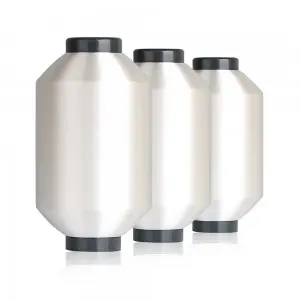What are the common quality problems of polyester hot melt yarn during winding?
As a common industrial material, polyester hot melt yarn may encounter a variety of quality problems during winding, which not only affect the appearance and performance of the product, but may also have an adverse effect on subsequent processing and application. The following are some common quality problems of polyester hot melt yarn during winding and their causes:
1. Unevenness of yarn dryness
Unevenness of yarn dryness is one of the important indicators to measure the quality of polyester hot melt yarn. During the winding process, if the wind temperature is not properly controlled, the melt yarn will not be cooled sufficiently, which will lead to an increase in the number of parallel yarns and bonded yarns, thereby increasing the unevenness of the yarn dryness. In addition, too low wind temperature will cause the melt to cool rapidly at the spinneret hole, increase the tensile stress, affect the pre-orientation degree and radial birefringence difference of the primary fiber, and then affect the spinning property
2. Strength and elongation of yarn
The strength and elongation of the yarn are its basic physical performance indicators. During the winding process, if the stretching process is not properly controlled, such as the stretching temperature, stretching multiple and stretching tension are not set reasonably, the strength and elongation of the yarn will not meet the requirements. In particular, the heat setting during the stretching process has a decisive influence on the final performance of the yarn.
3. Abnormal appearance of the yarn
During the winding process, hairy yarns and roller winding phenomena may occur, which will affect the breakage rate during the false twist deformation process, and thus affect the product quality. In addition, the yarn may have abnormal appearance such as bent angle yarns, broken ends, hairy yarns, and floating yarns. These abnormalities may be caused by factors such as too fast cooling speed and large radial temperature difference of single yarns.
4. Network degree and fastness problems
Network degree and fastness are important quality indicators of polyester hot melt yarn, which directly affect the post-processing performance and finished product quality of the product. During the network processing process, if the network pressure is set improperly, the network degree of POY may be insufficient, affecting its fastness.
5. Oil content problem
The oil content also has an important influence on the post-processing performance and finished product quality of polyester hot melt yarn. If the oil content is too high or too low, it may lead to an increase in the unevenness of the yarn, the CV value of the breaking strength and the CV value of the breaking elongation, affecting the product quality.
6. Winding tension problem
The size and stability of the winding tension have an important impact on the stability, excellent rate, quality index, post-processing performance and quality of the finished product of POY production. When the tension is large, the finished product package is tighter, the unevenness of the yarn increases, and the post-processing performance deteriorates; when the tension is small, the silk cake is softer, and it is easy to collapse, jump the pulley, and the winding diameter is too large. It is easy to unwind during post-processing, and it is very easy to cause the yarn to break.
7. Hot melt adhesive problem
During the bonding process of hot melt yarn, if the hot melt adhesive is heated for too short a time or the temperature is set too low, it may cause the adhesive to be weak; insufficient glue coating or too low substrate temperature will also affect the bonding effect.
In summary, there are many quality problems of polyester hot melt yarn in the winding process, involving process parameter control, equipment operation status, material characteristics and other aspects. In order to ensure product quality, these factors need to be comprehensively controlled and optimized. By precisely controlling process parameters, optimizing equipment operating conditions, and improving material quality, the occurrence of quality problems can be effectively reduced and the overall quality of polyester hot melt yarn can be improved.
Post time: Dec-27-2024

